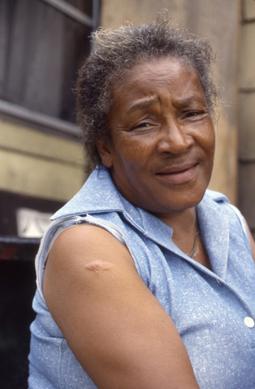Bessie Harvey facts for kids
Quick facts for kids
Bessie Harvey
|
|
|---|---|

Bessie Harvey, Golden Dreams (n.d.)
|
|
| Born |
Bessie Ruth White
October 11, 1929 |
| Died | August 12, 1994 (aged 64) |
| Nationality | American |
| Education | Self-taught |
Bessie Harvey (born Bessie Ruth White, October 11, 1929 – August 12, 1994) was an American artist. She was famous for her sculptures made from things she found, especially pieces of wood. Bessie was a very religious person. Her strong faith and love for nature were big inspirations for her art.
Contents
Early Life and Family Fun
Bessie Harvey was born in Dallas, Georgia. She was the seventh of thirteen children in her family. When she was fourteen, she married Charles Harvey. They settled in Buena Vista, Georgia.
In 1968, she divorced Charles and moved to Alcoa, Tennessee. By the time she was 35, she was raising eleven children! As a child, Bessie loved to make "something out of nothing." She often created her own toys and dolls. Besides her eleven children, Bessie also had twenty-eight grandchildren and three great-grandchildren.
Becoming an Artist: Bessie's Career
In 1977, Bessie Harvey started working as a housekeeper at Blount Memorial Hospital. To earn extra money, she would make dolls at night. She worked on them after everyone else was asleep.
When she showed her artwork at the hospital, people noticed it. Soon, art galleries became interested in her work. A doctor at the hospital introduced her to the Cavin-Morris Gallery in New York City. This gallery sold her artwork for many years. Bessie focused more and more on her art until she passed away in 1994.
Bessie's Amazing Artworks
Bessie Harvey's sculptures were usually made from wood. She decorated them with paint, beads, shells, cloth, and other found items. Her art was like a mix of sculpture, painting, and putting different things together.
Her work is part of a special art style from the American South. This style often uses found materials and religious ideas. Bessie believed that God was the main source of her art. She felt that God worked through her. She once said, "I’m really not the artist. God is the artist in my work."
Bessie believed God helped her see shapes in the wood she used. With this help, she could bring out the spiritual forms she saw in tree roots, branches, and driftwood. She loved nature because she felt she could connect with her ancestors' spirits in trees.
Her art often showed stories from the Bible, like those from Genesis and Revelation. She also created art about the experiences of African Americans in the United States. When she named her artworks, she often used an African-English dictionary. This helped her connect directly to her African heritage.
Where You Can See Bessie's Art
Bessie Harvey's art has been shown in over 50 exhibitions. One of her works, Cross Bearers, was bought by the Whitney Museum. It is now part of their permanent collection.
In 1997, the Knoxville Museum of Art held a big show just for her art. Her works are also in the permanent collections of the Knoxville Museum of Art and the American Folk Art Museum in New York.
Some of Bessie's art was bought by the Fine Arts Museums of San Francisco. These pieces were part of a collection of art by African American artists from the Southern United States. This art was shown in an exhibition called "Revelations: Art from the African American South."
Her work is also in the permanent collection of the National Gallery of Art in Washington, DC. It was part of an exhibit called Called to Create: Black American Artists of the American South. Bessie's art continues to be shown in museums today. These include the Philadelphia Museum of Art and the Turner Contemporary in England.
Bessie Harvey has inspired other artists, like Alison Saar. A street in Alcoa, Tennessee, has even been named after her!

